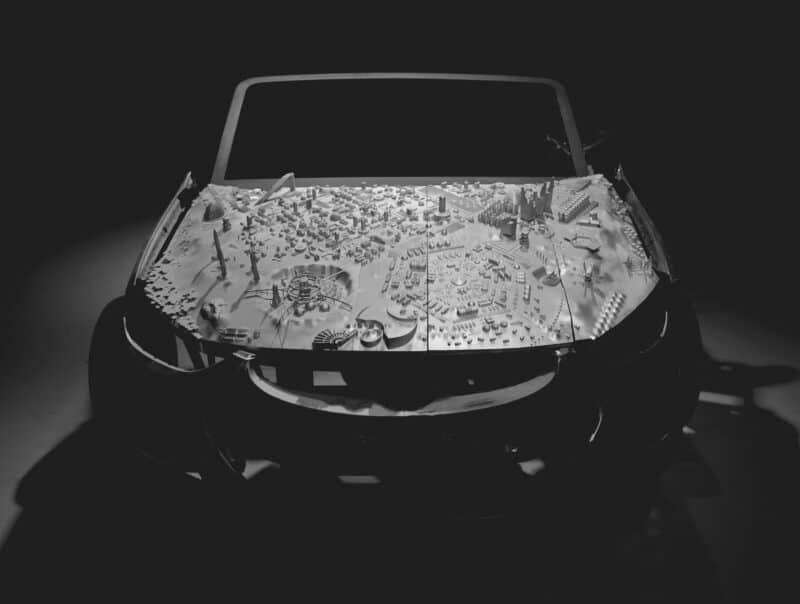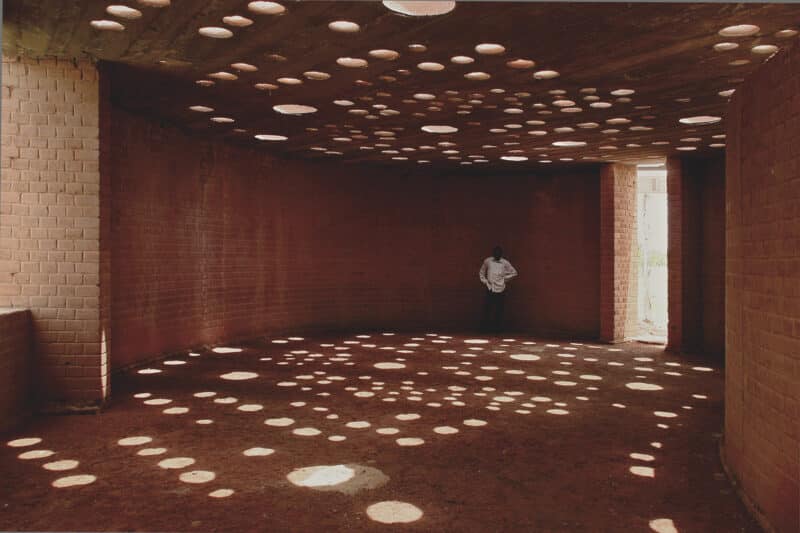Creative Intolerance
There is an allegory found in ancient Sanskrit texts of a swan that is often interpreted as a metaphor for spiritual progress. As the story goes, the graceful bird could separate nectar from a swamp, just as an enlightened sage separates the true self from the embodied self. I like to think of this “supreme swan” in the context of engineering. Could enlightened engineering help us discern the moral implications of our manufactured environments?
Engineering has long focused on the worldly—the “art of the possible”—rather than the nectar: the possibilities of art. Aiming to render what was once inconceivable into the inevitable, engineering has taken the practical attainment of prosaic goals as its highest calling. Engineers enable high-carbon habits, just as we promise to ease the emissions themselves. We entertain fanciful romances with data and algorithms that can lead us to grievous traps: unwanted, unintended, and unattended. In this world, the swan cannot separate the waters. The individual engineer must contend with what it means to be a good practitioner while straddling commerce and community, revenues and responsibility, safety and sustenance.
The Venice Biennale Architettura 2023 looks at some of these dichotomies with fresh eyes. It’s not aimed at engineering; it’s about architecture, the artsy cousin. But in this iteration, Lesley Lokko, the biennale’s first Black curator, shifts the typically Eurocentric pavilions to a collaborative experiment centered on Africa and its diaspora. Called The Laboratory of the Future, the collection is a vast material meditation on stories of decolonization and decarbonization. “The vision of a modern, diverse, and inclusive society is seductive and persuasive, but as long as it remains an image, it is a mirage,” Lokko notes.
The individual engineer must contend with what it means to be a good practitioner while straddling commerce and community, revenues and responsibility, safety and sustenance.
In society at large, equitable civics is frequently desired but rarely designed. What would it take for engineering to contribute to equity and related ideals? How could we shift from our narrow focus on touchpads and touchless transactions toward touchy subjects and their tradeoffs?
For starters, we might ask why engineering doesn’t have a biennale. Since 1895, Venice has presented art for the public to weigh in on; the focus on architecture started in 1980. People are invited to contemplate not just what architecture is (and how much it costs) but what it does—for the mind, the markets, and mother nature. The biennale attempts to have open-ended conversation with viewers, inviting compliments and criticism.
Some of the work is deliberately constructed to provoke. In the section “Dangerous Liaisons,” GRANDEZA STUDIO, a collective of artists and architects based in Spain and Australia, present their allegorical project Pilbara Interregnum. The interlinked multimedia installation uses the Pilbara, a pillaged region in the north of Western Australia, as a staging ground to unearth the forces behind relentless resource “expulsions, explosions, and exploitation.” One segment spotlights the hood of a car bearing a maquette that seems to portray an extractive battlefield: the supply chains for key minerals that are often hidden behind the fanfare of the vehicle. Exploring these vast technological regimes and the ideologies that power them, the studio points to the disconnect between technology and responsibility.

This provocation raises overt questions about the engineering worldview that the profession is only beginning to grapple with. For many years, engineers have implicitly reckoned with these questions when choosing between jobs with software companies, defense contractors, and municipal waste treatment facilities. When questions of ethics and motivations are not considered critically, and perhaps publicly, individual engineers may get the sense that the grace of the enlightened swan is not for them.
This biennale also ponders the meaning of earth itself—as a building material and as a way for communities to leverage ancient knowledge and local resources to shape their own futures. Architect Diébédo Francis Kéré from Burkina Faso is among those featured in the section “Force Majeure.”
Kéré grew up in a modest village east of Ouagadougou, where he sat through lessons in a small heat-locked classroom rigged from cement blocks. That suffocating structure shaped Kéré’s future and his Pritzker Prize-winning projects. He vowed to ensure a child’s right to a comfortable classroom. Kéré’s first plan—a primary school—was engineered by and for the approximately 2,500 people in his village of Gando, from concept to completion. Three rectangular classrooms line up like a granary, oriented east-west to limit severe heat. An elevated sheet roof over the ceiling provides shade and natural cooling. This technology was allied with bricks handmade and laid by local people. The completed project galvanized Gando, laying the foundation for literacy and ownership of public space. As Kéré put it: “If they build it themselves—like the school in Gando—and feel like they own it, they will take care of it.”

In Kéré’s vision, architecture is far more than a structure: it is a means of extending community through time. “Things are broken, and no one takes care to fix it,” he observes. “You have the feeling it’s owned by the government—but who is the government?” We tend to neglect that engineering itself has a governing—and a governance—role in civic life. Kéré’s work suggests that the function of the school is not only to care for the students but to encourage the community to care for its creation—and thus, to care for itself.
This communal sensibility can be found in the earliest examples of engineering. In present-day Pakistan, the ruins of Mohenjo-daro reveal a metal-age metropolis of 40,000 inhabitants built around 2500 BCE. Constructed on silt, the builders used wide, strategically laid foundations to anchor the city, with linked streets for wheeled transport. Almost every house had a bathroom and water-flushed latrine, located street-side to efficiently discharge effluents via tapered terracotta tubes into the catchments or drains. A grid of wells supplied fresh water transported by sloped shafts made of baked bricks. We know little about who these people were and why their civilization collapsed, but what remains clear is their commitment to civic infrastructure, which many parts of “modern” India lack today, millennia later.
When questions of ethics and motivations are not considered critically, and perhaps publicly, individual engineers may get the sense that the grace of the enlightened swan is not for them.
In this context, Kéré’s work is a reminder that good engineering is necessarily a product of scarcity and social engagement, and it doesn’t need to be fancy or frivolous. More recently, Kéré has worked on a community-built library in Gando. This elliptical building with a eucalyptus façade has become a conduit between the primary school and its extension, shielding the playground from dusty winds. The ceiling, embedded with sliced terracotta pots made in the community, provides round light openings. The slanted rays produce a dynamic pattern of lights and shadows, and the “stack effect” from the overhanging metal roof and polycarbonate sheet ventilates the inner space, together enriching the library’s spatial sense.
Engaging with these provocations has spurred me to offer my own: How might we challenge the idea of what engineering is and could be if we shifted our attention from Silicon Valley to the Indus Valley? Today’s vision of engineering is one based in mass production, not only of goods and software, but also of consumers. Could we turn these skills toward mass-producing responsible citizens and communities?
Kéré’s work is a reminder that good engineering is necessarily a product of scarcity and social engagement, and it doesn’t need to be fancy or frivolous.
Therein lies a touchy subject: Are we doing the right kinds of engineering? How should we invite the public in to discuss it at our own biennale? What might they discover? And how willing are we engineers to be provoked to reconsider the foundations of our unquestioned beliefs? To return to the allegory of the swan: we cannot learn to distinguish between what we can and cannot tolerate if we never examine the swamp in which we survive.
Sir Mortimer Wheeler, who organized detailed excavations of Mohenjo-daro in the 1940s, argued that in modern society, tolerance and passivity—not necessity—“scribbled” our sceneries with humanmade pillars, cables, and villas. He encouraged “creative intolerance,” by which he didn’t mean artistic narrowmindedness, but refusing to accept “dumb obediences” of thought that blunt critical judgment toward complex civic problems. Instead of carefully weighing our dilemmas, “we talk ourselves first into confusion and then into coma,” Wheeler said. The idea of creative intolerance, so evident in the installations of the Venice Biennale, is one way for engineering to seek something like enlightenment.
